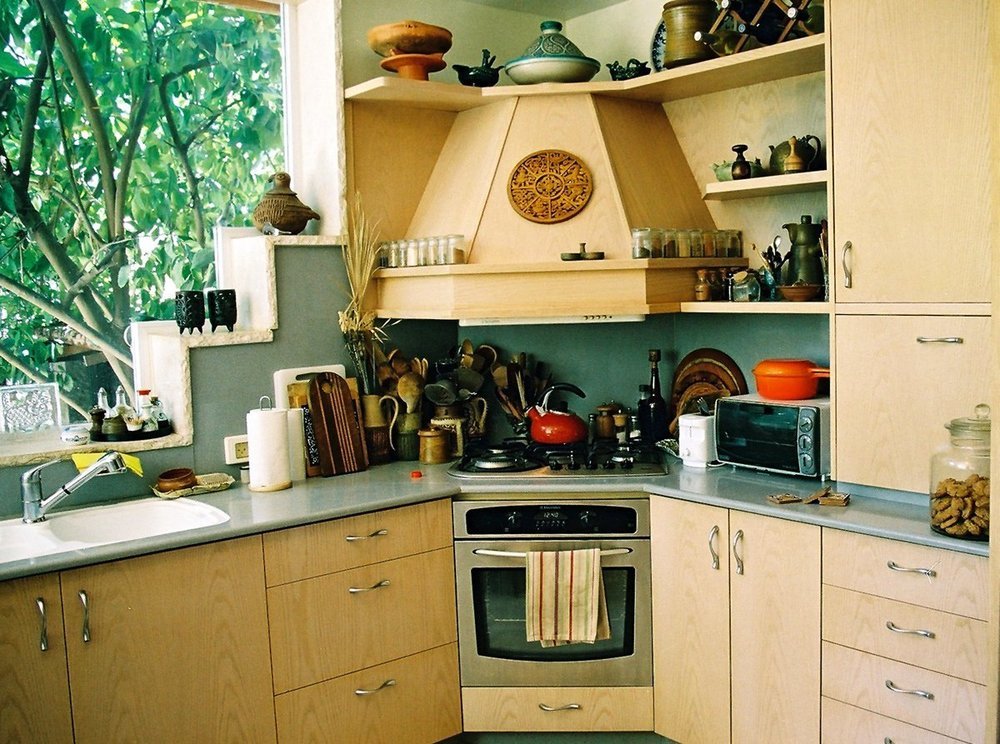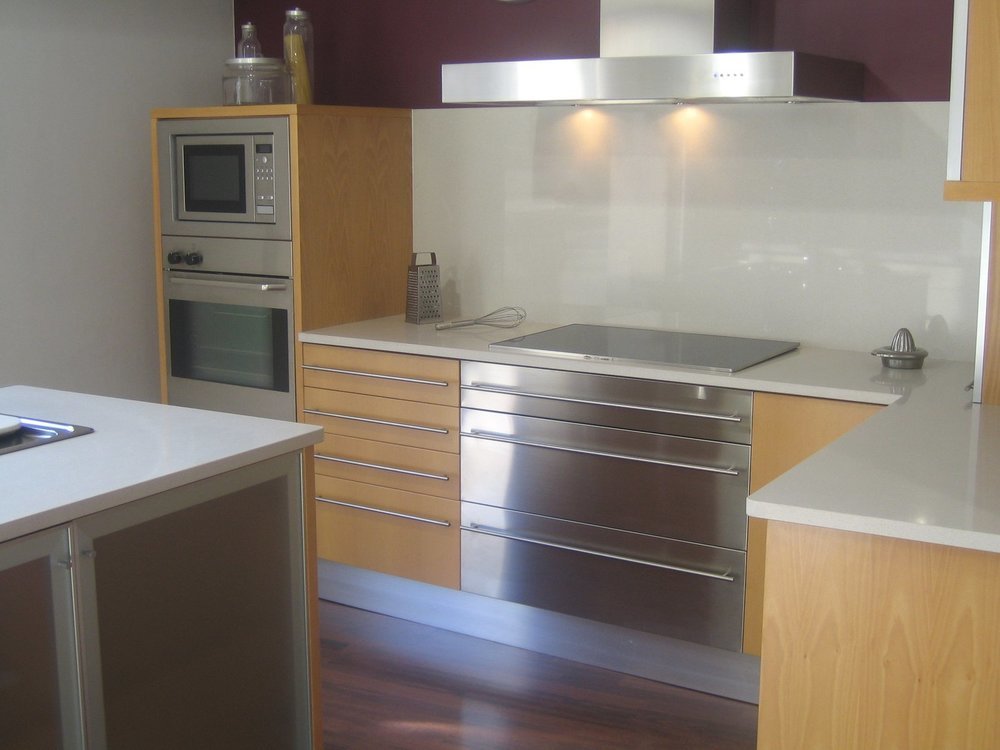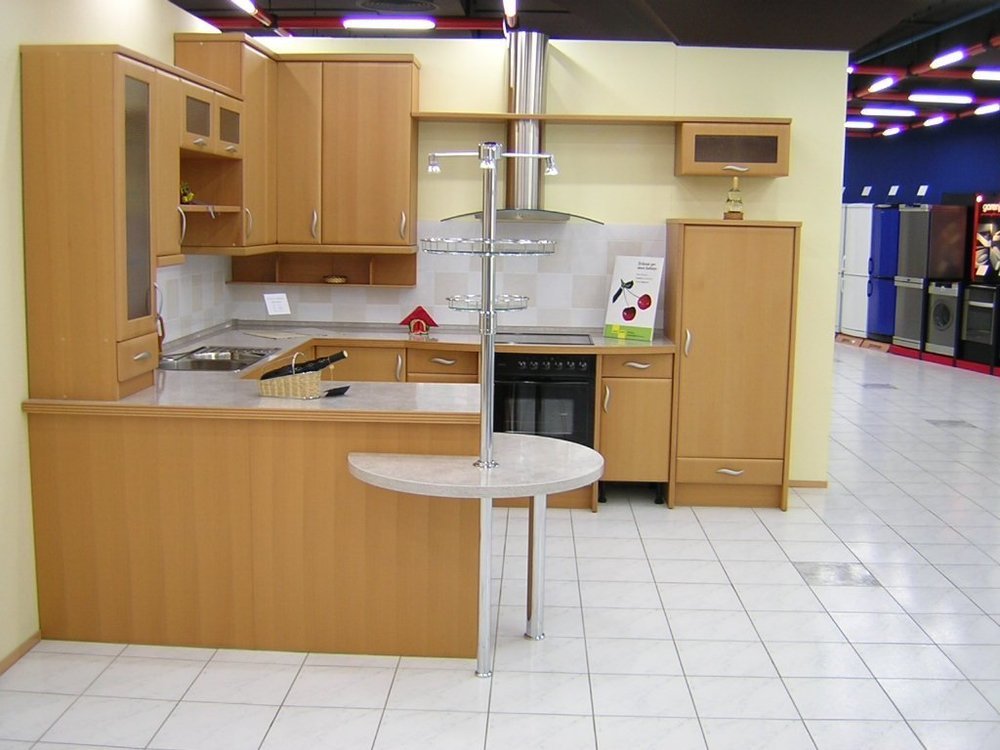 Kitchen Projects
Kitchen Projects
The Psychology of Color in Kitchen Design
The kitchen, often considered the heart of the home, is where cooking, socialising, and creativity converge. Colour significantly shapes the atmosphere of this central room. By understanding colour psychology, you can create a kitchen that’s not only beautiful but also promotes well-being and enjoyment.
Colour’s Influence in the Kitchen
Colours communicate subconsciously, influencing emotions, mood, and even appetite. In kitchen design, choosing colours that align with the desired mood and function is crucial. It’s more than just picking a favourite shade; it’s about understanding the subtle messages each colour sends.
Warm Colours
Warm colours, such as red, orange, and yellow, can make a kitchen a welcoming space. Think of terracotta-coloured walls or cabinets in a muted yellow hue, creating a sense of warmth and community. These colours can stimulate appetite and promote social interaction, making them ideal for kitchens that are a hub of activity. Kitchen Solvers highlights how warm tones create inviting vibes. For instance, a kitchen could feature walls in a soft, creamy beige, cabinetry in a rich, reddish-brown stain (reminiscent of natural wood, as discussed by Sunnyfields Cabinetry), and accents of vibrant, spicy orange in the bar stools or backsplash.
Balancing Warm Tones
To avoid an overpowering effect, consider the proportions of your colour choices. You might use a warm beige for the majority of the kitchen (walls, larger elements), a muted terracotta for some cabinetry (as suggested by A House in the Hills), and a brighter yellow for accessories or a small feature wall. This creates warmth without overwhelming the senses.
Cool Colours
Cool colours, like blue and green, have a calming effect, creating a sense of space and cleanliness. These are particularly well-suited for smaller kitchens or for those seeking a relaxed atmosphere. Light blue or pale green walls can evoke openness and freshness, while darker blue tones add a sophisticated touch. Research, as noted by sources like LIV:K, indicates that blue can promote relaxation. Imagine a kitchen with walls in a soft, calming sage green. Cabinets could be a muted, greyish-blue, adding sophistication. Accents of a brighter, turquoise blue in glassware or dish towels would complete the tranquil and refreshing space.
Creating a Calm Atmosphere
For a cool-toned kitchen, you might choose a light, airy blue for the walls, a crisp white for cabinets and countertops, and a vibrant green for the backsplash or accessories (as suggested by Kitchen Mania). This evokes calm and cleanliness, reflecting the sky and nature.
Neutral Colours
Neutral colours—white, beige, and grey—are classic kitchen choices, offering a flexible base adaptable to various styles. They create a clean, minimalist look, easily enhanced with accent colours. Neutral colours suit those who prefer a modern style and want the ability to easily change the kitchen’s look, as suggested by Homes & Gardens. A neutral palette offers incredible versatility. Walls and cabinets could be white, countertops and flooring light grey, and hardware, lighting fixtures, and accessories could be black or a bold colour for a modern look. The neutral backdrop allows the accent colour to truly shine.
Timeless Elegance
Consider a kitchen with walls in a warm, creamy off-white. Countertops and a backsplash could be a light, sandy beige. Accents of a rich, dark brown could be incorporated through wooden bar stools or pendant light fixtures. This creates a timeless and elegant space that feels both inviting and sophisticated.
Bold Colours
For a kitchen with strong character, bold colours like dark blue, emerald green, or even black can be exciting choices. These colours add drama and sophistication, making the kitchen unique. However, it’s important to balance strong colours with neutral elements to avoid overwhelming the space. Vestabul highlights the trend of two-toned kitchen cabinets, using different colours for upper and lower cabinets to create contrast and visual interest. For example, combine dark emerald green lower cabinets with crisp white upper cabinets and walls, and use brass or gold accents for hardware and lighting. This creates a luxurious feel, while the white keeps the space bright, as suggested by Peacock & Co.
Making a Statement
Another approach could be to feature walls in a deep, navy blue, with cabinetry in a crisp, clean white. Accents of a bright, cheerful yellow could be introduced through a tiled backsplash or kitchen linens. This creates a bold and dynamic space that is both energising and inviting.
Crafting Your Kitchen’s Colour Palette
When choosing a colour palette, consider these key factors:
Key Considerations
Here are a few things to think about when picking your colour scheme:
- Size and Light: In a small, dimly lit kitchen, bright colours can make the room feel larger, while dark colours can create cosiness in a larger kitchen. Natural light significantly impacts how colours appear. A north-facing kitchen might benefit from warmer tones, while a south-facing kitchen can handle cooler tones, as noted by Designer Listings.
- Desired Atmosphere: Consider how you use your kitchen. Whether it’s for quick meals or if you spend hours cooking and entertaining will influence your colour choices. Warm colours promote an energetic and social environment; cool colours contribute to a calm and relaxing space.
- Personal Style: Choose colours that resonate with you. Experiment with colours you love, even if they aren’t traditionally used in kitchens. The goal is a space that feels authentically you.
- Materials and Surfaces: Consider how colours interact with materials like countertops, cabinets, and flooring. Choose colours that complement each other. Pay attention to the undertones; a warm-toned wood floor might clash with cool-toned grey cabinets.
- Lighting’s Role: Both natural and artificial lighting affect colour perception. Observe paint colours under different lighting conditions before deciding. Warm LED lighting enhances warm colours; cool LED lighting complements cool colours. Elmira Stove Works suggests using dimmer switches to adjust lighting and create different moods.
- Specific Kitchen Styles: Different styles suit different colour palettes. A modern kitchen might feature monochromatic colours (white, grey, black) with a bold accent. A farmhouse kitchen might use natural tones (sage green, cream, warm wood). A traditional kitchen could use a classic combination of white/cream with navy blue or forest green, as suggested by Kitchen Solvers.
Colour and Different Kitchen Styles
Let’s explore how colour palettes can be tailored to specific kitchen styles:
- Scandinavian: This style embraces simplicity and functionality. A typical palette includes white, light grey, pale blue, and natural wood tones. This creates a bright, airy, and calming atmosphere.
- Industrial: This style often features darker greys, black, and exposed brick or concrete. Red accents can add a touch of warmth and energy. Metal finishes, like stainless steel or brushed nickel, are common.
- Coastal: This style evokes a beachy feel with light and airy colours. Think whites, creams, light blues, and sandy beiges. Accents of turquoise or coral can add a pop of colour.
- Farmhouse: This style often features warm and inviting colours, such as cream, beige, sage green, and soft yellows. Natural wood tones and vintage-inspired accents are common.
Current Trends and Sustainable Choices
Earthy and natural colours are currently trending, reflecting a desire for connection with nature and sustainability. There’s also increased demand for eco-friendly paints and materials with lower environmental impact, contributing to a healthier home. Spenza Ceramics emphasizes the importance of using low-VOC paints for indoor air quality. These trends aren’t just about aesthetics; they’re about making responsible choices that benefit both your home and the environment.
Looking Ahead
Colour psychology will continue to be a key element of kitchen design. We can expect to see even more creative and personalised colour choices, blending the impact of colour with sustainability and individual style. The evolution of colour will continue to inspire new design solutions, seamlessly merging aesthetics with functionality and emotional resonance, as highlighted across numerous sources, including Bryant Turner Kitchens.
Ready to transform your kitchen with the power of colour? Contact us today for a free design consultation!


